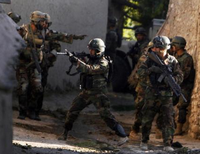Winning American wars these days is four parts politics and just one part fighting. Contemporary military doctrine -- counterinsurgency and stability operations -- tasks soldiers, on the whole, with state-building. Victory, or at least success, means building from the bottom up, rather than destroying from the top down. But because conditions on the ground are so delicate, for the one part of warfare that remains fighting, there's no room for error.
With Gen. Stanley McChrystal taking charge of U.S. and NATO troops in Afghanistan on Monday, warfighting is on everyone's minds. McChrystal has been appointed to command the Afghanistan war in large part because of his success in Iraq directing special operations -- the usually classified missions carried out under a cloak of secrecy. Many expect him to use a similar approach in Afghanistan. In doing so, he will face a coterie of challenges, in part due to the impact that civilian casualties and border issues have on the political battlefield that is Afghanistan, but also because of equipment shortages. Failure to successfully manage these challenges risks engendering a new generation of disaffected Afghans who will reduce the expression of American influence in South Asia to exactly what everyone is trying to avoid: a full-on war.
Special operations forces have come to form a core element of the country's military. In 1986, Congress established U.S. Special Operations Command, now based at MacDill Air Force Base in Tampa, to consolidate the special operations work of all four branches of the military. In total, there are about 54,000 special operations soldiers, the lion's share being drawn from the Army. And in the last year, the Army added another four battalions, at least two of which have already been stood up. Gen. McChrystal's appointment is an illustration of the more prominent role these special operations forces are playing in the conduct of the war.

